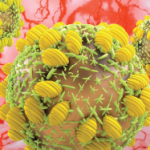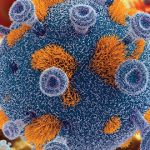The decision to continue IFN-a therapy in such cases should be individualized. If the chance of achieving viral clearance with IFN-a therapy is considered high (patients with genotypes -2/3 or patients with genotype -1 and low pretreatment viral load and/or a favorable virological response after three months of therapy), every effort should be made to continue IFN-a therapy. In such cases, the use of adjunctive medications for RA like low dose prednisone (<10 mg/day) or even anti–TNF-a agents could be tried.
In cases where the possibility of viral clearance is low (patients with genotype-1 and high pretreatment viral load and/or absence of virologic response after three months of therapy) or where a severe exacerbation of arthritis not controlled with therapy is noted, we believe that IFN-a therapy should be stopped.
Conclusions
HCV is a common chronic viral infection that affects the diagnosis and management of RA in numerous ways. Rheumatologists should become knowledgeable about the clinical aspects of HCV infection, develop standards for screening, and establish close relationships with hepatologists skilled in assessing and managing patients with these complex disorders. Still, there are a number of questions that need to be answered concerning the long-term safety of biologic therapies in patients with chronic hepatitis C, as well as the antiviral and antirheumatic efficacy of combination therapies with antivirals and biologics in this group of patients. A number of trials are already in progress that will try to answer these questions, and certainly more are needed in the future.
Dr. Vassilopoulos is assistant professor of medicine–rheumatology at Athens University in Greece. Dr. Calabrese is professor of medicine at Cleveland Clinic Lerner College of Medicine of Case Western Reserve University and R.J. Fasenmyer Chair of clinical immunology and vice chair of the department of rheumatic and immunologic diseases at the Cleveland Clinic Foundation.
References
- O’Dell JR. Therapeutic strategies for rheumatoid arthritis. N Engl J Med. 2004;350:2591-2602.
- Scott DL, Kingsley GH. Tumor necrosis factor inhibitors for rheumatoid arthritis. N Engl J Med. 2006;355:704-712.
- Rustgi VK. The epidemiology of hepatitis C infection in the United States. J Gastroenterol. 2007;42:513-521.
- Parke FA, Reveille JD. Anti-tumor necrosis factor agents for rheumatoid arthritis in the setting of chronic hepatitis C infection. Arthritis Rheum. 2004;51:800-804.
- Groom H, Dieperink E, Nelson DB, et al. Outcomes of a Hepatitis C screening program at a large urban VA medical center. J Clin Gastroenterol. 2008;42:97-106.
- Lauer GM, Walker BD. Hepatitis C virus infection. N Engl J Med. 2001;345:41-52.
- Strader DB, Wright T, Thomas DL, Seeff LB. Diagnosis, management, and treatment of hepatitis C. Hepatology. 2004;39:1147-1171.
- Manning DS, Afdhal NH. Diagnosis and quantitation of fibrosis. Gastroenterology. 2008;134:1670-1681.
- Vassilopoulos D, Calabrese LH. Rheumatic manifestations of hepatitis C infection. Curr Rheumatol Rep. 2003;5:200-204.
- American College of Rheumatology Subcommittee on Rheumatoid Arthritis Guidelines. Guidelines for the management of rheumatoid arthritis: 2002 Update. Arthritis Rheum. 2002;46:328-346.
- Mok MY, Ng WL, Yuen MF, Wong RW, Lau CS. Safety of disease modifying anti-rheumatic agents in rheumatoid arthritis patients with chronic viral hepatitis. Clin Exp Rheumatol. 2000;18:363-368.
- Calabrese LH, Zein NN, Vassilopoulos D. Hepatitis B virus (HBV) reactivation with immunosuppressive therapy in rheumatic diseases: Assessment and preventive strategies. Ann Rheum Dis. 2006;65:983-989.
- Armstrong WS, Taege AJ. HIV screening for all: The new standard of care. Cleve Clin J Med. 2007;74:297-301.
- Saag KG, Teng GG, Patkar NM, et al. American College of Rheumatology 2008 recommendations for the use of nonbiologic and biologic disease-modifying antirheumatic drugs in rheumatoid arthritis. Arthritis Rheum. 2008;59:762-784.
- Calabrese LH, Zein N, Vassilopoulos D. Safety of antitumour necrosis factor (anti-TNF) therapy in patients with chronic viral infections: Hepatitis C, hepatitis B, and HIV infection. Ann Rheum Dis. 2004;63 Suppl 2:ii18-ii24.
- Ferri C, Ferraccioli G, Ferrari D, et al. Safety of anti-TNF-alpha therapy in patients with rheumatoid arthritis and chronic HCV infection. J Rheumatol. 2008;35:1944-1949.
- Zein NN. Etanercept as an adjuvant to interferon and ribavirin in treatment-naive patients with chronic hepatitis C virus infection: A phase 2 randomized, double-blind, placebo-controlled study. J Hepatol. 2005;42:315-322.
- Cacoub P, Delluc A, Saadoun D, Landau DA, Sene D. Anti-CD20 monoclonal antibody (rituximab) treatment for cryoglobulinemic vasculitis: Where do we stand? Ann Rheum Dis. 2008;67:283-287.
- Russo MW, Fried MW. Side effects of therapy for chronic hepatitis C. Gastroenterology. 2003;124:1711-1719.
- Okanoue T, Sakamoto S, Itoh Y, Minami M, Yasui K, Sakamoto M, et al. Side effects of high-dose interferon therapy for chronic hepatitis C. J Hepatol. 1996;25:283-291.
- Passos de Souza E, Evangelista Segundo PT, José FF, Lemaire D, Santiago M. Rheumatoid arthritis induced by alpha-interferon therapy. Clin Rheumatol. 2001;20:297-299.
- Pittau E, Bogliolo A, Tinti A, et al. Development of arthritis and hypothyroidism during alpha-interferon therapy for chronic hepatitis C. Clin Exp Rheumatol. 1997;15:415-419.
- Nadir F, Fagiuoli S, Wright HI, et al. Rheumatoid arthritis: A complication of interferon therapy. J Okla State Med Assoc. 1994;87:228-230.
- Chazerain P, Meyer O, Kahn MF. Rheumatoid arthritis-like disease after alpha-interferon therapy. Ann Intern Med. 1992;116:427.

